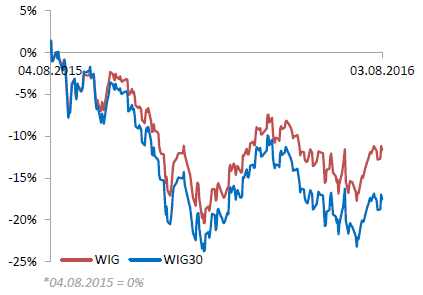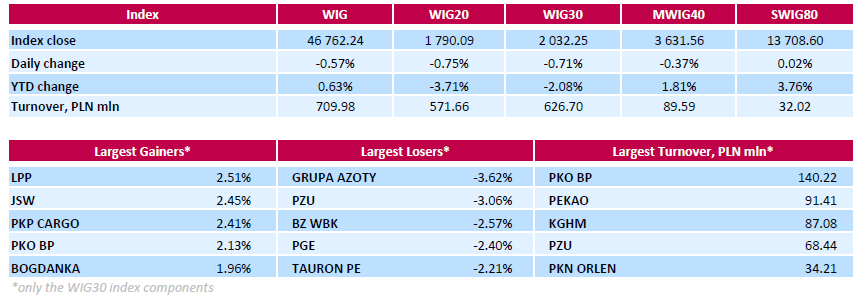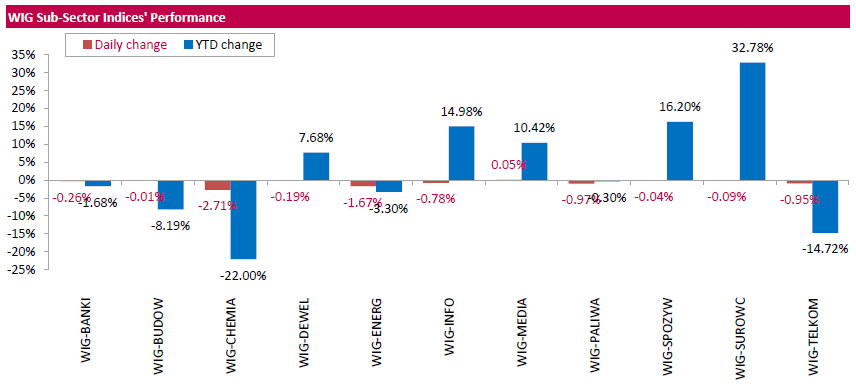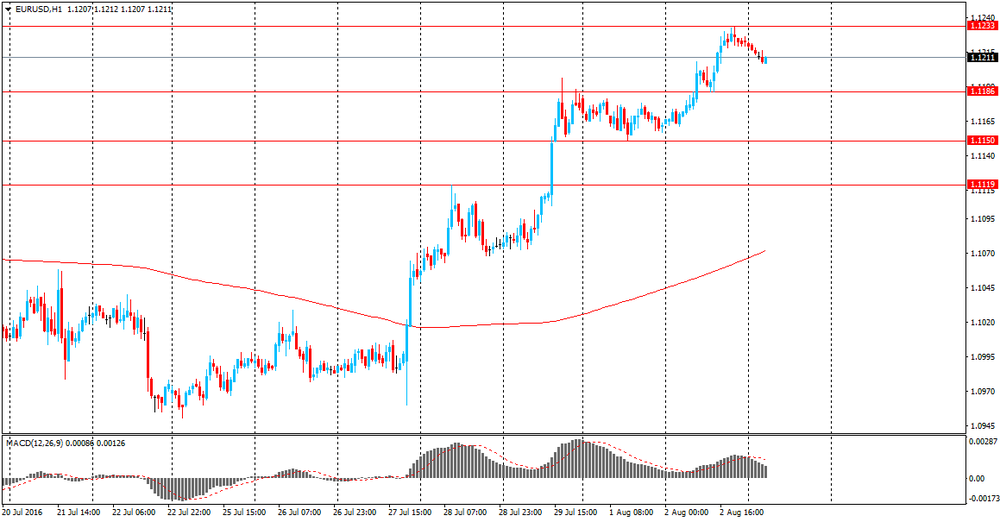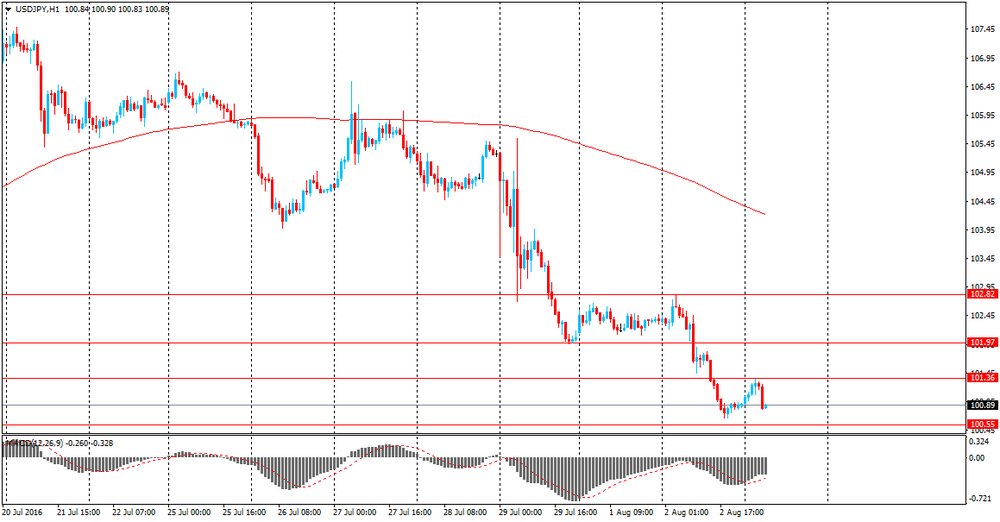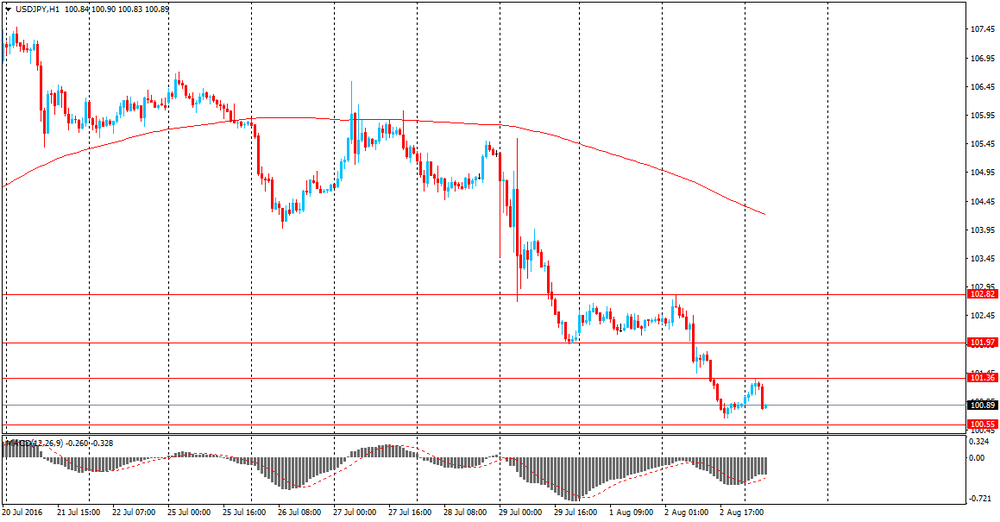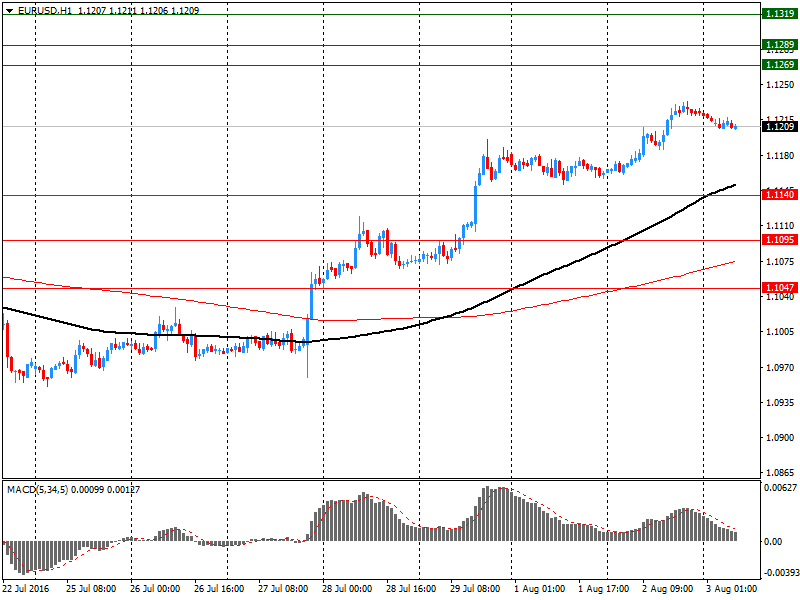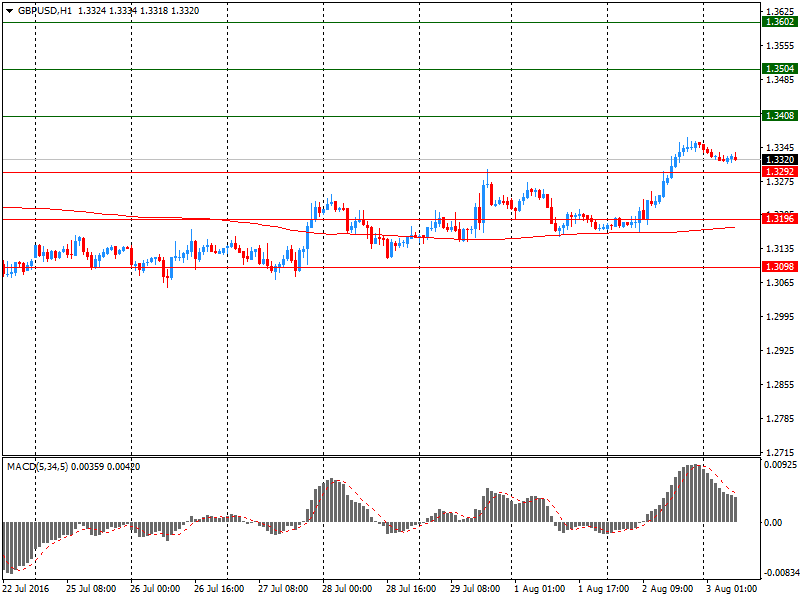Noticias del mercado
-
22:09
Major US stock indexes finished trading above zero

Major US stock indices closed in the green zone, as the strong labor market data helped the financial sector, and the recovery in oil prices sent the energy sector up.
As shown by data provided by Automatic Data Processing (ADP), employment growth in the US private sector accelerated in July, and were higher than forecasts of experts. According to the report, in July, the number of employees increased by 179 thousand. People in comparison with the upwardly revised figure for June at the level of 176 thousand. (Originally reported growth of 172 thousand.). Analysts had expected the number of people employed will increase by 170 thousand.
In addition, final data from Markit Economics showed: the seasonally adjusted index of business activity in the US service sector amounted to 51.4 points in July, unchanged compared with June. Previously it reported a decline to 50.9 points. It was expected that the index was 50.9 points.
It also became known that the index of business activity in the US service sector, calculated by the ISM, deteriorated in June, reaching a level of 55.5 points compared with 56.5 points in the previous month. According to the forecast value of the index was to drop to 56 points.
Oil prices jumped by about 4% and WTI crude oil rose back above $ 41 per barrel. Support to the market have the data from the Ministry of Energy of the United States, who reported a greater than expected reduction of stocks of gasoline. US Department of Energy announced that from 23 July to 29 July oil inventories rose 1.4 million barrels to 522.5 million barrels. Analysts had expected a decline of 2 million. Barrels. Oil reserves in Cushing terminal fell by 1.1 million barrels to 64.1 million barrels.
Most components of the DOW index finished trading in positive territory (16 of 30). More rest up shares JPMorgan Chase & Co. (JPM, + 1.49%). Outsider were shares of Pfizer Inc. (PFE, -3.13%).
Sector S & P index closed mixed. The leader turned out to be the basic materials sector (+ 1.3%). Most utilities sector fell (-0.5%).
At the close:
Dow + 0.22% 18,353.83 +40.06
Nasdaq + 0.43% 5,159.74 +22.01
S & P + 0.31% 2,163.72 +6.69
-
21:00
DJIA +0.03% 18,319.59 +5.82 Nasdaq +0.22% 5,148.93 +11.20 S&P +0.09% 2,159.02 +1.99
-
18:00
European stocks closed: FTSE 100 -11.00 6634.40 -0.17% DAX +25.87 10170.21 +0.26% CAC 40 -6.91 4321.08 -0.16%
-
17:49
Oil rose about 2 percent
Oil prices jumped about 2 percent, and WTI crude oil rose back above $ 40 per barrel. Support to the market have the data from the Ministry of Energy of the United States, who reported a greater than expected reduction of stocks of gasoline at the end of last week.
US Department of Energy announced that from 23 July to 29 July oil inventories rose 1.4 million barrels to 522.5 million barrels. Analysts had expected a decline in stocks by 2 million barrels. Oil reserves in Cushing terminal fell by 1.1 million barrels to 64.1 million barrels. Meanwhile, gasoline stocks fell by 3.3 million barrels to 238.2 million barrels. Analysts had expected a reduction of only 300,000 barrels. Distillate stocks rose 1.2 million barrels to 153.2 million barrels. This rate is still above the upper limit of the average range for this time of the year. Analysts had expected a decline of 100,000 barrels. The utilization of refining capacity increased by 0.9% to 93.3%. Analysts have suggested that the rate will remain unchanged. US domestic oil production decreased to 8.460 million barrels per day versus 8.515 million barrels a day the previous week. Yesterday the American Petroleum Institute reported that US crude stocks for the week ending 29 July fell by 1.3 million barrels, while gasoline inventories fell by 450 thousand barrels.
A further rise in the cost of oil hinders the strengthening of the US currency. Recall increase in the dollar makes the price of commodities, which are defined in the US currency more expensive for holders of other currencies.
In general, experts are skeptical about the prospects for the oil market, noting the increase in the number of drilling rigs operating in the US, as well as signals of recovery of exports from Libya. "The mood is still very pessimistic and depressing - said Commerzbank analyst Eugen Weinberg -. There are factors that should support oil, but at the moment there is no news that could convince investors that the turmoil is terminated."
The cost of the September futures on WTI rose to 40.24 dollars per barrel.
September futures price for North Sea petroleum mix of Brent crude rose to 42.73 dollars a barrel on the London Stock Exchange ICE Futures Europe.
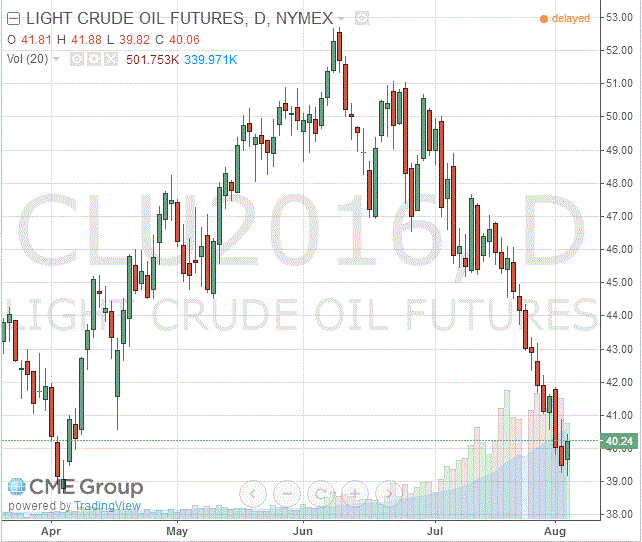
-
17:44
WSE: Session Results
Polish equity market closed lower on Wednesday. The broad market measure, the WIG Index, dropped by 0.57%. All sectors, but for media (+0.05%), were down, with chemicals (-2.71%) lagging behind.
The large-cap stocks' measure, the WIG30 Index fell by 0.71%. Within the Index components, chemical producer GRUPA AZOTY (WSE: ATT), insurer PZU (WSE: PZU), bank BZ WBK (WSE: BZW) and two gencos PGE (WSE: PGE) and TAURON PE (WSE: TPE) were the weakest performers, returning losses between 2.21% and 3.62%. On the other side of the ledger, clothing retailer LPP (WSE: LPP) led the advancers pack with a 2.51% growth. It was followed by coking coal miner JSW (WSE: JSW) and railway freight transport operator PKP CARGO (WSE: PKP), advancing 2.45% and 2.41% respectively.
-
17:29
Gold price decreased today
Gold fell nearly $ 10, away from the three-week high, which was caused by the renewed strengthening of the US currency on the back of strong employment data.
The report submitted by the Automatic Data Processing (ADP), showed that employment growth in the US private sector accelerated in July, and was higher than forecasts. According to the data, in July, the number of employees increased by 179 thousand. Analysts had expected the number of people employed to increase by 170 thousand.
Attention gradually switches to Friday's data on the US labor market. It is expected that the results of NFP to be around 175Kt. Investors believe that the data will be strong, so that the Federal Reserve in the next few months will be able to make a rate hike. Recall, the precious metal is sensitive to higher interest rates in the United States, but a gradual increase in rates carries less of a threat to gold. The rise in gold prices by 28 percent this year was largely due to a decrease in the likelihood that the Federal Reserve will soon continue with the rate hikes.
"We expect that the US economy remains on the path to" reasonable "growth, - said Oxford Economics Daniel Smith -. Despite the very poor performance of GDP, it is likely that employment statistics will be very good suporting the issue of increasing the interest rate back on the agenda. "
Gold reserves in the largest investment fund SPDR Gold Trust rose on Tuesday by 0.6 percent, to 969.97 tonnes.
The cost of the August gold futures on COMEX fell to $ 1355.60 per ounce.
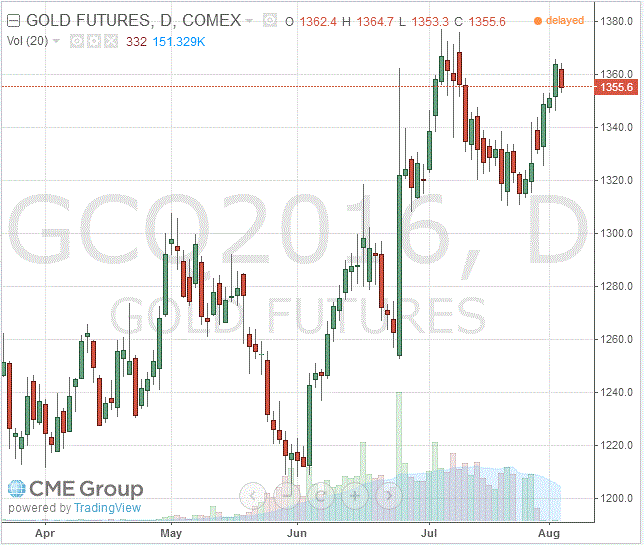
-
16:39
Last weeks crude oil inventories increased
U.S. crude oil refinery inputs averaged about 16.9 million barrels per day during the week ending July 29, 2016, 266,000 barrels per day more than the previous week's average. Refineries operated at 93.3% of their operable capacity last week. Gasoline production decreased last week, averaging 10.0 million barrels per day. Distillate fuel production increased last week, averaging over 4.9 million barrels per day.
U.S. crude oil imports averaged over 8.7 million barrels per day last week, up by 301,000 barrels per day from the previous week. Over the last four weeks, crude oil imports averaged 8.3 million barrels per day, 10.4% above the same four-week period last year. Total motor gasoline imports (including both finished gasoline and gasoline blending components) last week averaged 637,000 barrels per day. Distillate fuel imports averaged 96,000 barrels per day last week.
U.S. commercial crude oil inventories (excluding those in the Strategic Petroleum Reserve) increased by 1.4 million barrels from the previous week. At 522.5 million barrels, U.S. crude oil inventories are at historically high levels for this time of year. Total motor gasoline inventories decreased by 3.3 million barrels last week, but are well above the upper limit of the average range. Both finished gasoline inventories and blending components inventories decreased last week. Distillate fuel inventories increased by 1.2 million barrels last week and are above the upper limit of the average range for this time of year. Propane/propylene inventories rose 0.3 million barrels last week and are near the upper limit of the average range. Total commercial petroleum inventories increased by 2.1 million barrels last week.
-
16:30
U.S.: Crude Oil Inventories, July 1.413 (forecast -2)
-
16:06
US ISM non-manufacturing down 1 point from the previous month
Anthony Nieves, CPSM, C.P.M., CFPM, chair of the Institute for Supply Management® (ISM®) Non-Manufacturing Business Survey Committee:"the NMI® registered 55.5 percent in July, 1 percentage point lower than the June reading of 56.5 percent. This represents continued growth in the non-manufacturing sector at a slower rate. The Non-Manufacturing Business Activity Index decreased to 59.3 percent, 0.2 percentage point lower than the June reading of 59.5 percent, reflecting growth for the 84th consecutive month, at a slightly slower rate in July. The New Orders Index registered 60.3 percent, 0.4 percentage point higher than the reading of 59.9 percent in June. The Employment Index decreased 1.3 percentage points in July to 51.4 percent from the June reading of 52.7 percent. The Prices Index decreased 3.6 percentage points from the June reading of 55.5 percent to 51.9 percent, indicating prices increased in July for the fourth consecutive month. According to the NMI®, 15 non-manufacturing industries reported growth in July. The majority of the respondents' comments reflect stability and continued growth for their respective companies and a positive outlook on the economy."
-
16:00
U.S.: ISM Non-Manufacturing, July 55.5 (forecast 56)
-
16:00
Growth in the US services sector remained muted
July data suggested that growth in the U.S. service sector remained muted, with activity rising at the weakest pace in the current five-month sequence of expansion. A slower increase in new business was also recorded. On a more positive note, the rate of job creation picked up slightly and business sentiment improved markedly from June's record low. On the price front, slower increases were registered for both input costs and output prices during the month.
The seasonally adjusted Markit final U.S. Services PMI™ Business Activity Index1 registered 51.4 in July (earlier 'flash' estimate: 50.9), which was unchanged from the figure recorded in June and above the neutral 50.0 threshold for the fifth consecutive month. However, the latest reading remained indicative of only a very modest expansion of business activity that was softer than the post-crisis trend (55.4).
-
15:46
WSE: After start on Wall Street
The US data (ADP report showing the estimated change in employment in the United States in a given month, in the private sector outside agriculture) were slightly better than expected, but not enough to significantly deviate from the forecast to provoke serious reaction of markets. However, the reading of 179 thousand against a forecast of 170 thousand maintains the expectation that government data estimating the change in the number of jobs outside agriculture will be close to 180 thousand. Markets have adopted this report calmly.
On the Warsaw market develops correction which may call into question yesterday impetus for the entire index. The WIG20 went down despite the lack of discounts in Euroland, which creates a picture of a relative weakness of the Warsaw market.
-
15:46
U.S.: Services PMI, July 51.4 (forecast 50.9)
-
15:31
U.S. Stocks open: Dow -0.01%, Nasdaq -0.12%, S&P -0.05%
-
15:30
Option expiries for today's 10:00 ET NY cut
EUR/USD 1.1125 (EUR 500m) 1.1212 (270m)
USD/JPY 99.50 (USD (500m)
GBP/USD 1.3300 (GBP 370m)
EUR/GBP 0.8350 (EUR 260m)
AUD/USD 0.7500 (AUD 300m) 0.7540 (1.1bln)
USD/CAD 1.3100 (USD 421m)
-
15:08
Before the bell: S&P futures -0.17%, NASDAQ futures -0.19%
U.S. stock-index futures slipped amid corporate earnings and employment data, with investors on edge over prospects for growth after crude oil's retreat this week into a bear market.
Global Stocks:
Nikkei 16,083.11 -308.340 -1.88%
Hang Seng 21,739.12 -390.02 -1.76%
Shanghai 2,979.17 +7.89 +0.27%
FTSE 6,628.4 -17.00 -0.26%
CAC 4,298.66 -29.33 -0.68%
DAX 10,125.95 -18.39 -0.18%
Crude $39.83 (+0.81%)
Gold $1371.80 (-0.06%)
-
14:54
Wall Street. Stocks before the bell
(company / ticker / price / change ($/%) / volume)
ALCOA INC.
AA
10.35
0.06(0.5831%)
16474
ALTRIA GROUP INC.
MO
67.34
-0.00(-0.00%)
510
Amazon.com Inc., NASDAQ
AMZN
758.8
-1.78(-0.234%)
2945
AMERICAN INTERNATIONAL GROUP
AIG
56.65
2.51(4.6361%)
68906
Apple Inc.
AAPL
104.69
0.21(0.201%)
475686
AT&T Inc
T
42.94
-0.22(-0.5097%)
400
Barrick Gold Corporation, NYSE
ABX
22.64
-0.05(-0.2204%)
105348
Chevron Corp
CVX
99.65
0.06(0.0602%)
590
Cisco Systems Inc
CSCO
30.6
-0.02(-0.0653%)
600
Citigroup Inc., NYSE
C
42.9
-0.09(-0.2093%)
4500
Exxon Mobil Corp
XOM
86.87
-0.17(-0.1953%)
978
Facebook, Inc.
FB
122.66
-0.43(-0.3493%)
29052
Ford Motor Co.
F
12.03
0.09(0.7538%)
60125
Freeport-McMoRan Copper & Gold Inc., NYSE
FCX
12.35
-0.05(-0.4032%)
34550
General Electric Co
GE
31.08
0.03(0.0966%)
7205
General Motors Company, NYSE
GM
30.05
0.12(0.4009%)
8680
Google Inc.
GOOG
769.2
-1.87(-0.2425%)
931
Intel Corp
INTC
34.3
-0.00(-0.00%)
2990
Microsoft Corp
MSFT
56.45
-0.13(-0.2298%)
1217
Nike
NKE
54.4
-0.52(-0.9468%)
42723
Pfizer Inc
PFE
36.12
0.03(0.0831%)
3364
Starbucks Corporation, NASDAQ
SBUX
56.35
-0.38(-0.6698%)
8158
Tesla Motors, Inc., NASDAQ
TSLA
226.02
-1.18(-0.5194%)
4458
The Coca-Cola Co
KO
43.48
-0.05(-0.1149%)
4214
Twitter, Inc., NYSE
TWTR
16.26
-0.16(-0.9744%)
32486
Wal-Mart Stores Inc
WMT
72.6
-0.53(-0.7247%)
1665
Walt Disney Co
DIS
94.9
-0.11(-0.1158%)
2647
-
14:25
US: Private sector employment increased above forecasts in July
Private sector employment increased by 179,000 jobs from June to July according to the July ADP National Employment Report®
Payrolls for businesses with 49 or fewer employees increased by 61,000 jobs in July, down from 86,000 in June. Employment at companies with 50-499 employees increased by 68,000 jobs, up from last month's 56,000. Employment at large companies - those with 500 or more employees - increased by 50,000, up from June's 34,000. Companies with 500-999 employees added 16,000 and companies with more than 1,000 employees added 33,000 in July. Goods-producing employment was down by 6,000 jobs in July, following June losses of 28,000. The construction industry lost 6,000 jobs, following June losses of 4,000 jobs. Meanwhile, manufacturing gained 4,000 jobs after losing 15,000 the previous month.
-
14:15
U.S.: ADP Employment Report, July 179 (forecast 170)
-
13:45
Orders
EUR/USD
Offers : 1.1220 1.1230-35 1.1250 1.1280 1.1300-05 1.1335-40 1.1400
Bids: 1.1200 1.1180 1.1150 1.1120 1.1100 1.1085 1.1050
GBP/USD
Offers : 1.3320 1.3335 1.3355 1.3365 1.3385 1.3400 1.3450 1.3470 1.3500
Bids: 1.3280-85 1.3265 1.3250 1.3230-35 1.3200 1.3170 1.3150 1.3130 1.3100 1.3085 1.3050
EUR/GBP
Offers : 0.8450-55 0.8485 0.8500 0.8525 0.8550
Bids: 0.8400 0.8385 0.8365 0.8350 0.8330 0.8300
EUR/JPY
Offers : 113.50 113.80 114.00 114.50 114.80 115.00 115.20 115.50 115.80 116.00
Bids: 113.00 112.80 112.60 112.00-10 111.50 111.00 110.80-85 110.50
USD/JPY
Offers : 101.30-35 101.50 101.75-80 102.00 102.30 102.50-55 102.75-80 103.00 103.30 103.50
Bids: 101.00 100.65-70 100.50 100.00 99.85 99.50 99.30 99.00
AUD/USD
Offers : 0.7600 0.7620 O.7635 0.7650-55 0.7700 0.7720 0.7750
Bids: 0.7570 0.7570 0.7540-50 0.7520 0.7500 0.7480-85 0.7450 0.7420 0.7400
-
13:45
GBP: Risk For Selling Into And After BoE - Citi
"Our economics team is forecasting a 25bp cut in the bank rate and a resumption of QE - forecasting 75bn in purchases over the next 4-months. Forecasts for inflation and growth will be reduced.
The risk to sterling is two-fold:
Given the market expectations have been building for weeks, the bar for the BOE to deliver will be fairly high leaving an upside surprise difficult.
Still, we remain bearish on GBP. A resumption to rate cuts and asset purchases would be a long-run signal for Real Money accounts that have been slow to rebalance their asset holdings.
From that angle we see room for some GBP selling into and after the event" - efxnews.
-
13:19
Major stock indices in Europe show a moderate decline
Stock indices in Europe trading on concerns about economic growth in the euro area and Japan, stimulus package, the scope of which disappointed markets. Meanwhile, shares of most banks rise in price on strong statements.
Shares of the largest French banks Societe Generale and Credit Agricole rose by 4.3% and 2.5% due to an increase in their profit and revenue in the second quarter of 2016.
Quotes of British bank HSBC Securities jumped 3.4%. Europe's largest bank has reduced the profit and revenue in the second quarter, however, it announced its intention to buy back its own shares in the amount of $ 2.5 billion in the second half.
ING capitalization soared by 7.4%. The largest Dutch financial services group increased its net profit in April-June, almost 4 times to 1.3 billion euros thanks to the expansion of the loan portfolio, as well as the preservation of a stable margin.
Meanwhile, the share price of Continental AG products decreased by 1.6%, as profits for the last quarter fell short of market expectations.
Aggreko Plc securities price fell during trading by 12%. Scottish engineering company reported a decline in quarterly profit and revenue.
German publishing house Axel Springer has reduced the market value by 1.7% due to lower revenues in the preceding quarter.
AXA SA shares fell 0.4% after the second largest insurance company in Europe reported a 4% increase in net profit in the first half, below analysts' expectations.
Shares of Next Plc soared 3.6% after the retailer reported an increase in sales in the second quarter by 0.3% year on year, but warned that sales could fall by 2.5% in 2016.
At the moment:
FTSE 6627.90 -17.50 -0.26%
DAX 10142.24 -2.10 -0.02%
CAC 4311.36 -16.63 -0.38%
-
13:09
WSE: Mid session comment
Today's trading does not provide many attractions. Once again the region of 1,800 points was the market stabilizer. After the withdrawal in the first hour the market has found a balance in around the psychological barrier. A significant impact on the stabilization is analogous behavior of core markets. Closely followed in Warsaw the DAX ends mid-morning phase of session in the area of yesterday's close.
Yesterday's intraday lows on the PLN currency pairs has been cosmetically enhanced (to the greatest extent on the EUR / PLN due to withdrawal of Eurodollar), which indicates the still continuing positive sentiment for the domestic market. In the context of the Warsaw Stock Exchange this can therefore be taken at face value. While optimism can be seen on the zloty, light withdrawal of the WIG20 should not cause any serious damage for the bulls side.
The halfway point of trading the WIG20 greeted at the level of 1,799 points (-0.24%) and with the turnover slightly below PLN 250 mln.
-
11:07
Euro Zone retail sales volume unchanged in June
In June 2016 compared with May 2016, the seasonally adjusted volume of retail trade remained stable in the euro area (EA19) and declined by 0.2% in the EU28, according to estimates from Eurostat, the statistical office of the European Union. In May the retail trade volume increased by 0.4% in both zones. In June 2016 compared with June 2015 the calendar adjusted retail sales index increased by 1.6% in the euro area and by 2.4% in the EU28.
The stable volume of retail trade in the euro area in June 2016, compared with May 2016, is due to rises of 0.3% for non-food products and of 0.1% for "Food, drinks and tobacco", while automotive fuel decreased by 1.3%. In the EU28, the 0.2% decrease in the volume of retail trade is due to decreases of 1.0% for automotive fuel and 0.2% for "Food, drinks and tobacco", while non-food products increased by 0.2%. Among Member States for which data are available, the highest increases in total retail trade were registered in Portugal (+3.1%), Romania (+2.0%) and Spain (+1.0%), while the largest decreases were observed in Ireland (-1.6%), Estonia (-1.5%) and Poland (-1.0%).
-
11:00
Eurozone: Retail Sales (MoM), June 0% (forecast 0%)
-
11:00
Eurozone: Retail Sales (YoY), June 1.6% (forecast 1.7%)
-
10:39
Option expiries for today's 10:00 ET NY cut
EUR/USD 1.1125 (EUR 500m) 1.1212 (270m)
USD/JPY 99.50 (USD (500m)
GBP/USD 1.3300 (GBP 370m)
EUR/GBP 0.8350 (EUR 260m)
AUD/USD 0.7500 (AUD 300m) 0.7540 (1.1bln)
USD/CAD 1.3100 (USD 421m)
-
10:35
Oil trading almost flat
This morning, the New York futures for WTI oil rose by + 0.05% to $ 39.55 and Brent oil futures were down -0.10% to $ 41.77 per barrel. Thus the black gold has limited activity amid anticipation of the US Department of Energy data on oil reserves in the country. The market expects that data will point to the decline in crude oil and gasoline at the end of last week. Also, according to API, oil reserves for the week fell by 1.3 million barrels, while gasoline stocks - 450 thousand barrels.. According to estimates US crude stocks for the week fell by 900 thousand barrels and gasoline fell 300 thousand barrels.
-
10:32
The UK service sector registered a fall in business activity in July
The UK service sector registered a fall in business activity in July, according to the latest PMI® survey data from IHS Markit and CIPS. Output and new business both declined for the first time in over three-and-a-half years, and at the fastest rates since early-2009. Consequently, employment in the sector was unchanged since June, ending a three-and-a-half-year period of uninterrupted job creation. The 12-month outlook for activity weakened sharply to the lowest since February 2009, linked to uncertainty regarding 'Brexit'.
The headline figure for the survey is the seasonally adjusted Markit/CIPS UK Services Business Activity Index, a single-figure measure designed to track changes in total UK services activity compared with one month previously.
Readings above 50.0 signal growth of activity compared with the previous month, and below 50.0 contraction. The Business Activity Index fell to 47.4 in July, from 52.3 in June, signalling a fall in UK services output. This was the first contraction since December 2012, and the rate of decline was the strongest since March 2009.
-
10:30
United Kingdom: Purchasing Manager Index Services, July 47.4 (forecast 47.4)
-
10:23
Stronger services activity in the Euro Zone in July
The rate of eurozone economic expansion ticked higher at the start of the third quarter. This was signalled by the final Markit Eurozone PMI® Composite Output Index rising to a six-month high of 53.2 in July, above the earlier flash estimate of 52.9. The headline index has now signalled growth for 37 successive months.
The rate of expansion in manufacturing production steadied at June's six-month high. Growth of service sector output improved slightly but remained slower than that seen at manufacturers. Although the latest data signalled a solid and steady pace of expansion, national data suggested that the upturn was uneven by nation. Growth was primarily driven by an accelerated rate of output expansion in Germany, the fastest during the year-to-date. Rates of growth moderated in Italy and Spain, whereas France continued to hover around the stagnation mark.
-
10:00
Eurozone: Services PMI, July 52.9 (forecast 52.7)
-
09:57
German service providers reported further growth
German service providers reported further growth of both output and new orders at the start of the third quarter. The respective rates of growth accelerated slightly since June and were above their respective long-run averages. Moreover, companies were encouraged to add to their payrolls, which in turn helped alleviate some pressure on operating capacity.
Meanwhile, the pass through of sharply rising input costs resulted in a further increase in overall charges. The final seasonally adjusted Markit Germany Services Business Activity Index posted above the neutral 50.0 threshold that separates growth from contraction for the thirty-eighth consecutive month in July. Rising from June's 53.7 to 54.4, the index signalled an acceleration in the rate of expansion. According to anecdotal evidence, growth in output was driven by rising demand and higher investments.
-
09:55
French services sector activity improves
Service providers in France reported a rise in business activity for the third time in the past four months during July. That said, the rate of growth was marginal overall. New business received by service providers increased moderately, contributing to a further rise in backlogs of work. Employment grew marginally, while companies' business expectations remained positive. Input prices rose modestly, whereas there was a further drop in prices charged.
The seasonally adjusted headline Markit France Business Activity Index - which is based on a single question asking respondents to report on the actual change in business activity at their companies compared with one month ago - posted 50.5 in July. Up from 49.9 in June, the latest index reading pointed to a marginal rate of expansion that was broadly in line with the average seen during 2016 so far (50.3).
The final seasonally adjusted Markit France Composite Output Index - which covers the combined manufacturing and service sectors - registered 50.1 in July. Up from 49.6 in June, the latest index reading was indicative of broadly no change in private sector activity during the latest survey period.
-
09:55
Germany: Services PMI, July 54.4 (forecast 54.6)
-
09:51
France: Services PMI, July 50.5 (forecast 50.3)
-
09:50
July’s survey highlighted stronger demand for services in Italy - Markit
Italy's services economy remained in expansion territory at the start of the third quarter, according to the latest PMI® survey data from IHS Markit. Furthermore, the pace of job creation signalled was the fastest since August 2007 amid stronger growth in incoming new business. However, firms' optimism towards the year-ahead outlook for business activity eased to the lowest for 32 months.
The headline Markit Business Activity Index - which is based on a single question asking respondents to report on the actual change in business activity at their companies compared to one month ago - moved to 52.0 in July, up fractionally from June's 51.9. That pointed to the continuation of a modest pace of growth in business activity that was broadly in line with the average over 2016 so far. The best performing sub-sector was Renting & Business Activities, followed by Financial Intermediation. Reflective of the ongoing upturn in the services economy, businesses raised employment levels for the tenth month in succession during July. Furthermore, having accelerated since June, the rate of job creation reached the fastest seen for nearly nine years. July's survey highlighted stronger demand for services in Italy, with inflows of new business having increased amid reports of new clients being acquired. The rate of growth in new work was at a five-month high, though only moderate overall.
-
09:36
Spanish service sector remained comfortably in growth territory in July
The Spanish service sector remained comfortably in growth territory in July, with further solid rises in activity and new business recorded. The rate of job creation remained marked, having eased only slightly from the previous month's recent high. Business sentiment eased, but remained positive. Meanwhile, rates of inflation of both input costs and output prices accelerated but remained muted. The headline seasonally adjusted Business Activity Index dropped slightly to 54.1 in July from 56.0 in June. The reading signalled a further solid expansion in activity, albeit the weakest since February.
Service sector output has now risen in each of the past 33 months, with panellists reporting the launch of new services and signs of improving client demand. Each of the six broad sectors monitored by the survey saw activity increase, with the sharpest expansion at Hotels & Restaurants. The category also posted a marked rise in new business, with Post & Telecommunications another strong performer.
-
09:28
Major stock exchanges began trading mixed: DAX 10,147.43 + 3.09 + 0.03%, FTSE 100 6,662.86-31.09-0.46%
-
09:16
WSE: After opening
WIG20 index opened at 1806.56 points (+0.16%)*
WIG 47095.32 0.14%
WIG30 2050.15 0.16%
mWIG40 3642.04 -0.08%
*/ - change to previous close
The futures market (WSE: FW20U1620) began in the area of yesterday's close, which is broadly in line with changes in environment. The daily chart indicates that the game begins on the resistance level, which have already been tested, so there is no new technical content.
Europe began the day with no surprises. The WIG20 index inscribed in the environment, and after the first trades increase of 0.3 percent can be considered as a simple transfer of atmosphere from the environment. The focus is of course the banking sector, which helps positive response to the result of Pekao (WSE: PEO) and harmful light withdrawal entire banking basket with the forefront leaders of yesterday's increases.
-
09:07
Asian session review: usd stabilized
The Australian dollar was supported by strong iron ore prices and US dollar weakness. Also, the Australian currency rose by about 2% contrary to RBA decision to lower interest rates by 25 basis points to a record low of 1.50%.
Data on the index of activity in the service sector of Australia AiG show an incrase to 53.9 points, which is higher than the previous value of 51.3. Increased activity in the Australian services sector for the third consecutive month. Of the five sub-indices of the sector the highest growth was observed in the sector of sales to 59.4, the strongest level since August 2015. Deliveries rose by 6.0 points to 54.2, and inventories increased by 6.2 points to 52.8 points.
New orders remained stable at 52.2, while employment decreased by 3.1 points to 50.0 points.
Three of the nine sub-sectors were stable. Retail trade rose to 65.0, the finance and insurance to 62.0 and services to 53.2. Other sub-sectors oshowed a decline: wholesale to 48.9, personal and entertainment services to 46.7. The weakest growth rate observed in the sub-sector of transport and storage 33.6 points.
In China, Caixin services PMI fell in July to 51.7 from 52.7 the previous value. The index was also lower than the official data on business activity index of the services sector, which amounted to 53.9 points.
Caixin PMI is a leading indicator of China's state sector services. A value above 50 indicates growth, while falling below this level indicates contraction.
All index categories showed signs of deterioration. The greater deterioration observed in the employment category, which kept growing in the last three months.
The yen is trading near the yesterday's high as the Japanese government measures do not meet market expectations. The total amount of the stimulus program amounted to Y28 trillion and it became one of the most significant for Japan in the aftermath of the global financial crisis.
The US dollar traded in a narrow range against the euro, after yesterday's significant decline, helped by investors' flight from risk, as well as the widespread weakening of the US currency due to recent disappointing GDP report. Investors are concerned that the weak GDP data will reduce the likelihood of tighter monetary policy of the Fed. Today futures on interest rates suggest 18% probability of rate hike in September and 35% probability in December.
Markets gradually switched to the data on US labor market, which will be published on Friday. Some investors believe that the employment data will be strong, so that the Federal Reserve in the next few months will be able to make a rate hike.
Today, the US will release the index of business activity in the services sector from the Institute for Supply Management. The indicator is the result of a survey of about 400 companies from 60 sectors across the United States, including agriculture, mining, construction, transport sector, communications, wholesale and retail companies. The index consists of four equally weighted components: business activity, new orders, employment, suppliers and shipping. ISM index value greater than 50 is usually considered as an indicator of the growth of industrial activity, but less than 50, respectively, falls. It is expected that the index fell to 56.0 from 56.5 in June.
EUR / USD: during the Asian session, the pair was trading in the $ 1.1200-05 range
GBP / USD: during the Asian session, the pair was trading in the $ 1.3300-05 range
USD / JPY: during the Asian session, the pair was trading in Y100.75 - 101.05 range
-
08:52
Bitcoin plunged after hackers stole about $65 million - Bloomberg
Bitcoin plunged after one of the largest exchanges halted trading because hackers stole about $65 million of the digital currency.
Bitcoin slumped 5.5 percent against the dollar as of 2:30 p.m. on Wednesday in Tokyo, bringing its two-day drop to 13 percent. Prices also sank 6.2 percent on Monday, although it was not clear if that initial move was related to the hack.
Hong Kong-based exchange Bitfinex said Tuesday it halted trading, withdrawals and deposits after discovering the security breach. The exchange said it was still investigating details and cooperating with law enforcement, but acknowledged some bitcoins were stolen from its users.
"Yes -- it is a large breach," Fred Ehrsam, co-founder of Coinbase, a cryptocurrency wallet and trading platform, wrote in an e-mail. "Bitfinex is a large exchange, so it is a significant short term event, although Bitcoin has shown its resiliency to these sorts of events in the past."
-
08:25
Expected negative start of trading on the major stock exchanges in Europe: DAX-0.1%, CAC40 -0.1%, FTSE -0.1%
-
08:25
WSE: Before opening
Tuesday's session on Wall Street ended with a slight declines and the S&P500 index retreated by 0.64 percent. The whole of yesterday's session may be called a day of waiting for more important part of the week, which will bring the monthly data from the USA labor market and in this context, Wednesday will be the day of the warm-up before the most important sessions of the week. Today's ADP report will be read as a predictor of government data, which will appear on Friday.
In Europe, the most important event of the week will be Thursday's decision of the Bank of England, which should cut interest rates in response to the negative effects of the Brexit referendum in the UK.
On the Warsaw market, the situation is somewhat more complicated. Yesterday's reflection on the shares of banks - associated with mild version of the President's proposals regarding currency loans - oriented the WSE market in a position detached from the environment and other exchanges. Strong increases in stock prices of banks resulted in return of the WIG20 above 1,800 pts., but we have to keep in mind about another cause of repricing the banking sector in the form of already introduced tax assets, which does not disappear.
-
08:22
Options levels on wednesday, August 3, 2016:
EUR/USD
Resistance levels (open interest**, contracts)
$1.1319 (3736)
$1.1289 (2708)
$1.1269 (3353)
Price at time of writing this review: $1.1209
Support levels (open interest**, contracts):
$1.1140 (1816)
$1.1095 (2860)
$1.1047 (3239)
Comments:
- Overall open interest on the CALL options with the expiration date August, 5 is 38669 contracts, with the maximum number of contracts with strike price $1,1300 (3736);
- Overall open interest on the PUT options with the expiration date August, 5 is 51412 contracts, with the maximum number of contracts with strike price $1,0900 (5600);
- The ratio of PUT/CALL was 1.33 versus 1.33 from the previous trading day according to data from August, 2
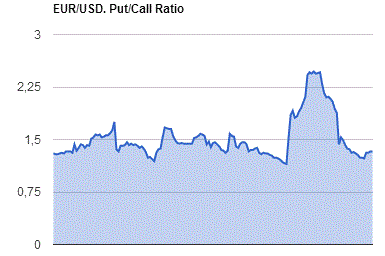
GBP/USD
Resistance levels (open interest**, contracts)
$1.3602 (1784)
$1.3504 (1871)
$1.3408 (2156)
Price at time of writing this review: $1.3320
Support levels (open interest**, contracts):
$1.3292 (438)
$1.3196 (718)
$1.3098 (2631)
Comments:
- Overall open interest on the CALL options with the expiration date August, 5 is 28778 contracts, with the maximum number of contracts with strike price $1,3400 (2156);
- Overall open interest on the PUT options with the expiration date August, 5 is 27139 contracts, with the maximum number of contracts with strike price $1,2950 (3099);
- The ratio of PUT/CALL was 0.94 versus 0.96 from the previous trading day according to data from August, 2
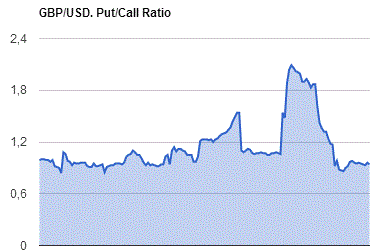
* - The Chicago Mercantile Exchange bulletin (CME) is used for the calculation.
** - Open interest takes into account the total number of option contracts that are open at the moment.
-
08:20
Staying EUR Long; Staying USD Offered - Morgan Stanley
"EUR support in the wings, staying long: There will be conclusions to be drawn for other currencies deploying NIR policy such as CHF, SEK or EUR. The short end of these currencies has priced in local central banks either keeping current monetary accommodation in place or cutting rates even further.
The Japanese experience could undermine this expectation, adding another reason why EUR should rally from here. In line with our interest rate strategy team, we see rate and yield differentials becoming more EURUSD-supportive. EURGBP longs remain our best trade.*
Staying USD offered: Increasingly, we differentiate between currencies with 'exploited' and still normal, i.e., positively yielding curves. Due to the lack of transmission mechanisms, expansionary monetary policy instruments no longer stimulate economies within an environment of 'exploited' yield curves. Here central banks will have to hope for external factors to turn the outlook for the better or they will have to aim for new - more revolutionary - measures. Friday's outcome of the BoJ meeting suggests that the authorities were not yet ready to step into new, untested territories.
Where yield curves are still normal and positively yielding, central banks are still willing to ease, as illustrated by today's RBA. However, the now more limited scope of yield curves makes them use the interest rate instrument only reluctantly. This is why the RBA did not provide forward guidance on rates today, limiting the FX- weakening impact. As a result, we do not expect much new information from Friday's Statement of Monetary Policy. In countries where yield curves are 'exploited', currencies should rise, driven by rising real yields. Consequently, USD should remain offered".
*Morgan Stanley maintains a long EUR/GBP position in its strategic portfolio and a long EUR/USD as a tactical trade of the week - efxnews.
-
08:10
Japanese government approved stimulus package
The Japanese government approved JPY 28 trillion stimulus that the Prime Minister Shinzo Abe had promised last week to bolster the economy.
The government plan includes JPY 13.5 trillion fiscal measures, of which JPY 7.5 trillion is set aside for central and local government spending starting this fiscal. Another JPY 6 trillion will be provided for low-cost loans.
The program will support infrastructure projects and reconstruction works in earthquake hit areas.
Further, media reports said the government will give cash handouts of JPY 15,000 to 22 million low-income people.
-
08:06
New Zealand jobs grow strongly
Job numbers rose a strong 3.1 percent in the year to the June 2016 quarter (as measured by the QES), driven in part by accommodation and food services, construction, and health services. This compares with a 2.2 percent increase in filled jobs in the year to the March 2016 quarter.
"There were 14,000 more jobs in accommodation and food services, up a strong 11 percent in the June year," business prices manager Sarah Williams said.
While job numbers have grown, annual wage growth remained subdued in a period of low consumer price inflation.
Annual wage inflation (as measured by the LCI) increased 1.5 percent in the June 2016 year, in line with levels for the past three years. Over the latest June year, the consumer price index, which measures the prices of goods and services that households buy, rose 0.4 percent.
"The gap between the labour cost index and inflation was 1.1 percentage points, the smallest gap since the end of 2014," Williams said.
The 1.5 percent increase in the LCI in the June 2016 year compares with a 1.6 percent increase in the year to the March 2016 quarter. Private sector wage inflation was 1.6 percent for the latest June year; for the public sector it was 1.3 percent.
-
07:46
ANZ Commodity Price Index up 2% in July
The ANZ Commodity Price Index continued its recent run of form with world prices up a further 2.0% m/m in July. It's the third consecutive improvement with prices up 6.9% over this period. The gains have been broad-based too, which is encouraging. However, it has to be remembered this improvement is off a near seven year low registered in April.
The other challenge is the high NZD, which continues to erode any slight improvement in world prices back to New Zealand exporters. In fact, while world prices have risen by 6.9% over the last three months, NZD prices have only improved by 2.5% over the same period and remain below the same time last year (-5.7% y/y). The NZD/USD is up 7% and trade-weighted index 8% compared with last year. Many exporters have worked hard on new innovations, productivity drivers and fostering new business, but sometimes this can only take things so far.
-
07:44
China's services sector activity decreased in July
Caixin services PMI fell in July to 51.7 from 52.7 the previous value. The index was also lower than the official data on business activity index of the services sector, which amounted to 53.9 points.
Caixin PMI is a leading indicator of China's state sector services. A value above 50 indicates growth, while falling below this level indicates contraction.
All index categories showed signs of deterioration. The greater deterioration observed in the employment category, which kept growing in the last three months.
-
07:17
Global Stocks
European stocks closed in negative territory Tuesday as bank shares came under pressure, leading the way lower.
The Stoxx Europe 600 SXXP, -1.29% fell 1.3% to end at 335.47.
Among banks, shares of Commerzbank AG CBK, -8.40% sank 9.2% as the German lender warned it won't hit its target of stable net profit for the full year.
Meanwhile, Italy's Banca Monte dei Paschi di Siena BMPS, -16.10% lost 16%. The shares had rallied during Monday's session after the bank's board late Friday approved a privately backed rescue plan for nonperforming loans at the embattled bank.
But BMPS still fared the worst among the 51 banks in the European Banking Authority's stress tests, released late Friday. The Italian banking sector was highlighted as one of the weaker spots in Europe's financial landscape.
U.S. stocks bounced off session lows but still closed lower Tuesday, marking the seventh straight daily loss for the Dow industrials and ending a five-day win streak for the Nasdaq, as investors sifted through quarterly results as well as data on personal income and inflation.
The Dow Jones Industrial Average DJIA, -0.49% fell as much as 157 points but ended with a decline of 90.74 points, or 0.5%, at 18,313.77/
The S&P 500 Index SPX, -0.64% settled with a loss of 13.81 points, or 0.6%, at 2,157.03, paring an earlier 23-point decline, with nine out of 10 main sectors trading lower, led by the consumer-discretionary and industrial sectors.
The Nasdaq Composite Index COMP, -0.90% took the worst of the fall, dropping 46.46 points, or 0.9% to finish at 5,137.73/
Asian shares bowed lower on Wednesday while the yen lorded over a weakened U.S dollar as talk the Bank of Japan may retreat from its massive bond-buying campaign twigged a shakeout in debt markets globally.
Worryingly for energy shares, the broad-based decline in the dollar was still not enough to spare U.S. crude oil from its first finish under $40 a barrel since April.
Japan's Nikkei .N225 lost 1.4 percent as the rising yen pressured exporter stocks while financials slid 2.7 percent.
The sharpest moves were in sovereign bond markets where a sudden spike in yields stirred speculation that a multi-year bull run in prices might finally be nearing its end.
Japanese bonds have suffered their worst sell-off in more than three years as investors feared the BoJ was out of easing ammunition and might leave it to fiscal policy to stimulate the economy.
Brent crude LCOc1 was near four-month lows on Wednesday at $41.86 a barrel. NYMEX crude CLc1 edged up 15 cents but at $39.66 was still under the psychological $40 level.
-
03:45
China: Markit/Caixin Services PMI, July 51.7 (forecast 52.9)
-
01:36
Australia: AIG Services Index, July 53.9
-
00:32
Commodities. Daily history for Aug 02’2016:
(raw materials / closing price /% change)
Oil 39.72 +0.53%
Gold 1,370.30 -0.17%
-
00:31
Stocks. Daily history for Aug 02’2016:
(index / closing price / change items /% change)
Nikkei 225 16,391.45 -244.32 -1.47%
Shanghai Composite 2,970.93 +17.54 +0.59%
S&P/ASX 200 5,540.54 -46.854 -0.84%
FTSE 100 6,645.4 -48.55 -0.73%
CAC 40 4,327.99 -81.180 -1.84%
Xetra DAX 10,144.34 -186.18 -1.80%
S&P/TSX Composite 14,477.01
S&P 500 2,157.03 -13.81 -0.64%
Dow Jones 18,313.77 -90.74 -0.49%-105.73 -0.73%
-
00:31
Currencies. Daily history for Aug 02’2016:
(pare/closed(GMT +3)/change, %)
EUR/USD $1,1222 +0,53%
GBP/USD $1,3350 +1,28%
USD/CHF Chf0,9644 -0,35%
USD/JPY Y100,91 -1,44%
EUR/JPY Y113,24 -0,90%
GBP/JPY Y134,72 -0,12%
AUD/USD $0,7603 +0,91%
NZD/USD $0,7235 +0,94%
USD/CAD C$1,3104 -0,18%
-
00:01
Schedule for today, Wednesday , Aug 03’2016:
(time / country / index / period / previous value / forecast)
01:45 China Markit/Caixin Services PMI July 52.7 52.9
07:50 France Services PMI (Finally) July 49.9 50.3
07:55 Germany Services PMI (Finally) July 53.7 54.6
08:00 Eurozone Services PMI (Finally) July 52.8 52.7
08:30 United Kingdom Purchasing Manager Inde Services July 52.3 47.4
09:00 Eurozone Retail Sales (MoM) June 0.4% 0.1%
09:00 Eurozone Retail Sales (YoY) June 1.6% 1.7%
12:15 U.S. ADP Employment Report July 172 170
13:45 U.S. Services PMI (Finally) July 51.4 50.9
14:00 U.S. ISM Non-Manufacturing July 56.5 56
14:30 U.S. Crude Oil Inventories July 1.671
-
